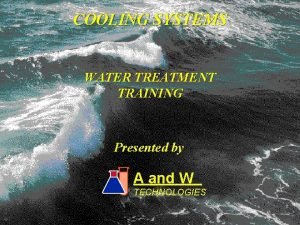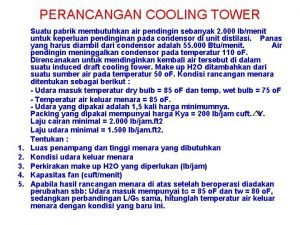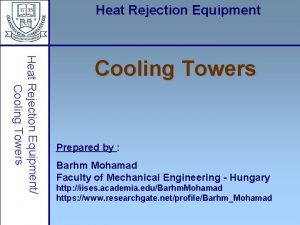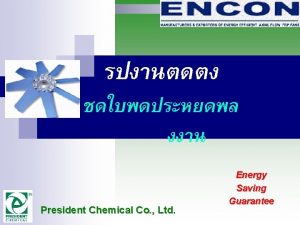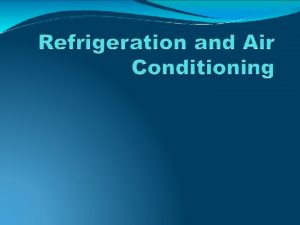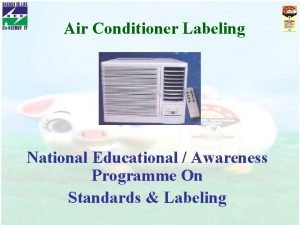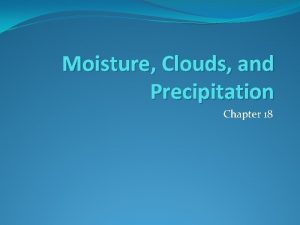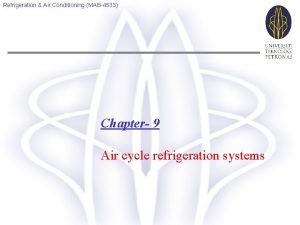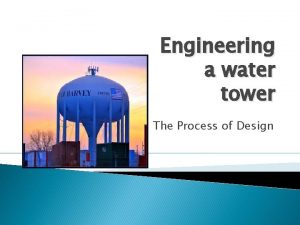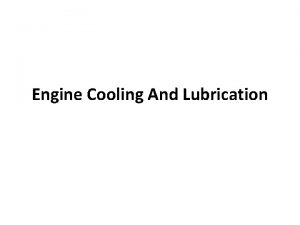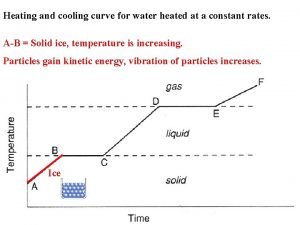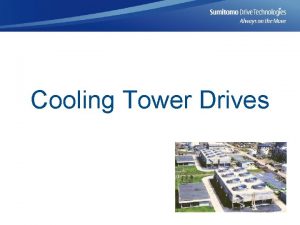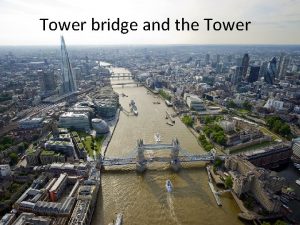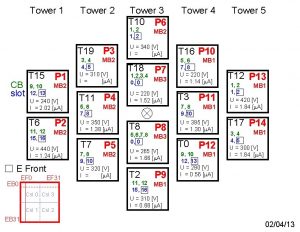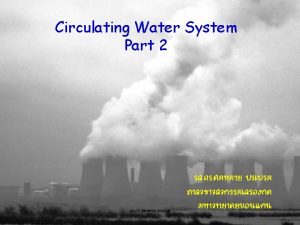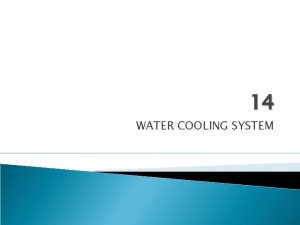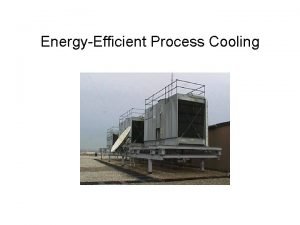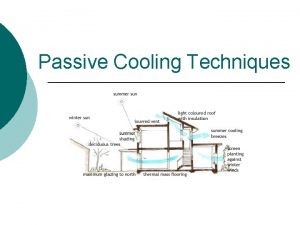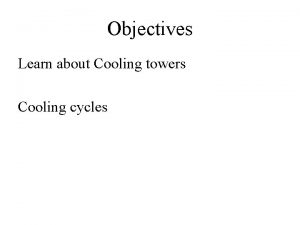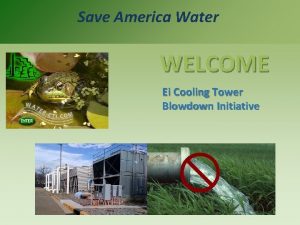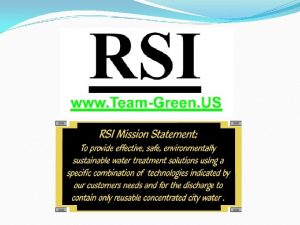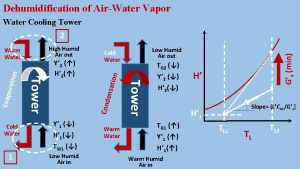Water Cooling with Air Cooling Tower The most













- Slides: 13

Water Cooling with Air (Cooling Tower) • The most important operation Liquid (Warm water) Humid air out (Warmed water is cooled by contact with atmosphere air) • The latent heat of water is so large (as compare with sensible heat) L’ 2 TL 2 • Lewis relation applies (Le =1. 0) for the air-water system L’ 2 TL 2 Unknowns TL 1 Gas in: TG 1 , Y’G 1 , H’G 1 Modeling Z Z G’s Tower Knowns TG 1 Cooled water out TL 1 Y’G 1 H’G 1 Gas in (Air)

Water Cooling with Air (Cooling Tower) Humid air Liquid out (Warm water) Energy balance in CV (III): L’CALd. TL=G’s{Csd. TG+[CA(TG-To)-CAL(TLTo)+λo]d. Y’} L’CALd. TL= G’s. Csd. TG+G’sλod. Y’ = G’s(Csd. TG+λod. Y’) H’=Cs(TG-To)+λo. Y’ Cs=CB+CAY’ L’CALd. TL = G’sd. H’ L’ = Constant Tower The sensible heat terms are ignored in comparison with the latent heat d. H’=Csd. TG+λod. Y’ L’CALd. TL ≈ G’sd. H’ L’CAL(TL 2 -TL 1)= G’s(H’ 2 -H’ 1) Cooled water out Operating Line Gas in (Air)

L’CAL(TL 2 -TL 1)= G’s(H’ 2 -H’ 1) (H’i vs Ti) TL 2 Humid air out Liquid (Warm water) 2 Slope=(L’CAL/G’s) max H’ 2 2 1 Slope=(L’CAL/G’s) 1 G’s (min) Cold water out H’ 1 TL 2 Water Liquid Temperature (TL) H’ 2 Tower Enthalpy of air-vapor mixture (H’) Water Cooling with Air (Cooling Tower) Operating Line Equilibrium curve TL 1 H’ 1 Gas in (Air)

Water Cooling with Air (Cooling Tower) Mass transfer: NAMAa. Md. Z= -G’s d. Y’= MAFG[ln(1 -PAi/Pt)/(1 -PAG/Pt)]a. Md. Z = MAk. G(PAi-PAG)a. Md. Z = MBPBmk. Y(Y’i-Y’)a. Md. Z G’sd. Y’ = k. Y(Y’i-Y’)a. Md. Z Energy balance in CV (gas-I): -G’s. Csd. TG= h’Ga. H(TG-Ti)d. Z → G’s. Csd. TG= h. Ga. H(Ti-TG)d. Z Energy balance in CV (Liquid-II): L’CALd. TL= [G’s. CALd. Y’-h. La. Hd. Z](Ti-TL) 0 L’CALd. TL= h. L(TL-Ti)a. Hd. Z If the sensible heat of transfer vapor is ignored: Energy balance in CV (III): L’CALd. TL= G’s. Csd. TG+G’sλod. Y’ ≈ G’sd. H’ L’CALd. TL= h. Ga. H(Ti-TG)d. Z + λo k. Y(Y’i-Y’)a. Md. Z = G’sd. H’

Water Cooling with Air (Cooling Tower) Enthalpy of gas-vapor mixture (H’) Operating Line L’CAL(TL 2 -TL 1)= G’s(H’ 2 -H’ 1) II Liquid d. Z TL Ti H’ 2 TL 1 H’G III TL H’ H’ 1 . Ti I Gas Liquid Temperature (TL) TL 2 TL H’ Ti H’i

Water Cooling with Air (Cooling Tower) L’CALd. TL= h. Ga. H(Ti-TG)d. Z + λo k. Y(Y’i-Y’)a. Md. Z = G’sd. H’ If r = h. Ga. H/(Csk. Ya. M) G’sd. H’ = k. Ya. M[(Csr. Ti + λo. Y’i) – (Csr. TG + λo. Y’)]d. Z Le (Lewis relation) = h. G/Csk. Y a. M ≈ a. H for Air-Water syatem → Le ≈ 1 r = h. Ga. H/(Csk. Ya. M) ≈ 1 H’i H’ G’sd. H’ = k. Ya. M[(Cs. Ti + λo. Y’i) – (Cs. TG + λo. Y’)]d. Z G’sd. H’ = k. Ya(H’i – H’)d. Z

Water Cooling with Air (Cooling Tower) G’sd. H’ = k. Ya(H’i – H’)d. Z Energy balance in CV (Liquid-III): L’CALd. TL= G’sd. H’ = k. Ya(H’i – H’)d. Z = h. La(TL-Ti)d. Z TL H’ Ti H’i Slope = -(h. La/k. Ya) Enthalpy of gas-vapor mixture (H’) Energy balance in CV (Liquid-II): L’CALd. TL= h. L(TL-Ti)a. Hd. Z Ti H’i TL H’ Liquid Temperature (TL)

Water Cooling with Air (Cooling Tower) G’sd. H’ = k. Ya(H’i – H’)d. Z = h. La(TL-Ti)d. Z Integration Ht. G Nt. G = Z t. G = transfer in gas phase

• Average driving force Enthalpy of gas-vapor mixture (H’) Water Cooling with Air (Cooling Tower) • Numerical solutions Ti H’i TL H’ Liquid Temperature (TL) Ht. G Nt. G = Z

Enthalpy of gas-vapor mixture (H’) Water Cooling with Air (Cooling Tower) t. OG = transfer overall in gas phase H’* Ti H’i TL H’ Liquid Temperature (TL) ↑ ↑ Ht. OG Nt. OG = Z

Water Cooling Tower Important thing in cooling tower modeling: Liquid (Water) Air out Tower Wet-Bulb Temperature Approach 2. 5 -5 o. C Water out TL 1 TW 1 Gas in (Air)

Water Cooling Tower • Evaporation Losses (E) • Windage Losses (W) Warm Water Blowdown (xo) (0. 1 -0. 3% of L) • Make Up (M) • Blowdown (B) Mass balance: M=E+W+B xi. M=xo(W+B) Air out Evaporation Losses Plant (Q) Windage Losses Make up (xi) Cold Water Gas in (Air)

The sensible heat terms are ignored in comparison with the latent heat For 1 kg liquid water (2. 205 lbm) Heat from 32 o. F to 212 o. F Sensible Heat : q. S=m. Cp(T 2 -T 1) Cp for liquid water=4. 2 J/g. K=1 Btu/lbm. R q. S=2. 205*1*(212 -32)=396. 9 Btu Latent Heat (T=32 o. F)=q. L=mλ=mhfg q. L=2. 205*1075. 8=2372. 1 Btu
 Cooling tower water treatment training
Cooling tower water treatment training Water and water and water water
Water and water and water water Perancangan cooling tower
Perancangan cooling tower Cooling tower approach temperature
Cooling tower approach temperature Encon fans
Encon fans Hubungan air dengan tanah
Hubungan air dengan tanah Simple air cooling system
Simple air cooling system Air conditioner cooling capacity
Air conditioner cooling capacity In order for clouds to form cooling air must be
In order for clouds to form cooling air must be Cop in refrigeration
Cop in refrigeration Water tower challenge
Water tower challenge Inside of a water tower
Inside of a water tower Lubrication of couling systems
Lubrication of couling systems Heating curve of water
Heating curve of water
